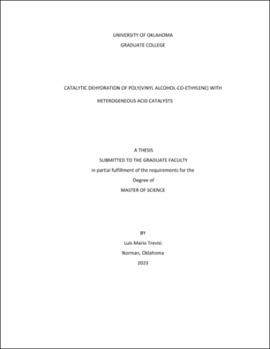| dc.description.abstract | This study investigates the role of acid site density, pore size, and solvent selection in the
catalytic dehydration of Poly (vinyl alcohol-co-ethylene) (EVOH) using zeolite catalysts. The first
set of experiments reveals that catalysts with lower acid site densities and larger pores exhibit
higher maximum rates and better activity retention after deactivation, attributed to enhanced
mass transfer through additional available pores. Conversely, zeolites with higher acid site
densities demonstrate consistently higher maximum rates overall, but lower acid site density
zeolites outperform them when normalized, emphasizing the significance of larger pores and the
mass transfer limited nature of this reaction. External active sites are found to play a crucial role
in the polymer dehydration reaction, as their removal leads to reduced maximum rates and faster
catalyst deactivation.
The investigation of solvents shows that use of DMSO results in limited reactivity with
zeolite catalysts, potentially due to competition for acid sites or inhibition of certain transition
steps. In contrast, a water-propanol mixture proves effective in dissolving EVOH while reducing
the degree of competition compared to DMSO. Thus, this solvent offers better activity while also
enabling additional chemistry like alcohol-induced ether formation. However, the ratio of water
to 1-propanol significantly impacts catalyst performance, with a 12.5% water loading resulting in
optimum rates possibly due to a combination of water competing for the active sites and the
degree of solvation of the polymer.
However, challenges in analyzing results with NMR due to sampling inconsistencies make
inviable a detailed study of the underlying mechanism and rates for this reaction under solvated
environment. Cryomilling was used to improve random sampling, but heterogeneities in the final
polymer sample persisted, accentuating the difficulties of characterization. DSC and FTIR analyses
confirm these heterogeneities and highlight the need to find techniques that analyze
representative samples to achieve accurate measurements | en_US |

